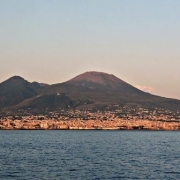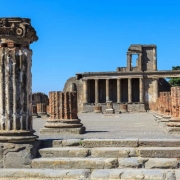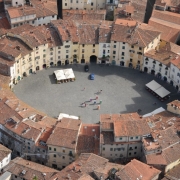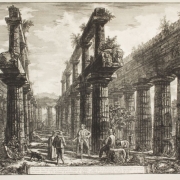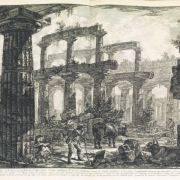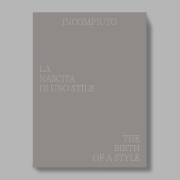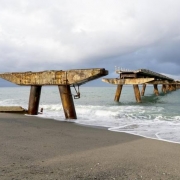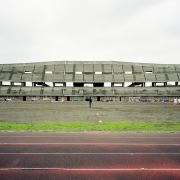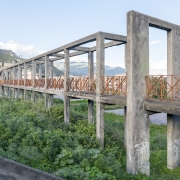In an era like the one we live in, where the formal sterility of architecture has been in force for some time, the invention by a collective of artists and architects of a new style may perhaps overturn the situation of bewilderment in which the current architectural panorama lives.
“… for powerful, famous cities,
which the proud mountain crushed
with all their people, beneath the torrents
from its fiery mouth. Now all around
is one ruin,
where you root, gentle flower, and as though
commiserating with others’ loss, send
a perfume of sweetest fragrance to heaven,
that consoles the desert…” 1
Giacomo Leopardi, Canti, 34
We are in Naples, on the slopes of the Vesuvius volcano and the poet Giacomo Leopardi contemplates the landscape. The emotion that the poet from Recanati evokes is of dismay and resignation towards a land recently hit by the eruption of the Neapolitan mountain. Nature is the central protagonist. Mother who knows how to generate, but who also has the power to destroy. Man is helpless and impotent. In fact, all his efforts to fight it would only be in vain and useless. This is the irreversible cosmic order which, according to the poet, governs the entire universe and decides its fate.
Giacomo Leopardi is a troubled poet, and fits in with what is called the artistic-literary movement of Romanticism. It was born in opposition to Neoclassicism, a cultural trend that roots in the late 18th century in England. The word romantic, with the initial meaning of “romance poetry thing”, which became property of the eighteenth century, which used the term to identify movement. This cultural current undertakes, through music, painting and literature, to deal with imaginative themes, enhancing the mysterious and melancholy, rejecting rationalism and perfection, abandoning religious subjects and the exaltation of the powerful, while the landscape becomes one of the favourite themes to represent passions and dreams. As a good romantic poet, Leopardi mentions the cities of Pompeii and Herculaneum in “Wild Broom”, once glorious, but which were then razed to the ground by Nature, personified in Vesuvius. Therefore, only ruins remained to be admired and remembered for their imposing past, which frame a sublime and abandoned landscape, precisely romantic.
In the centuries before the poet, however, not much importance was given to the historical ruins that testified to the presence of a civilization. A concrete example is provided by the famous amphitheatre of Lucca, a Roman-Byzantine city, which, in the 6th century AD, had to defend itself from the sieges of the Goths. To strengthen the defences of the city, citizens used the old walls of the amphitheatre as a foundation for the construction of the new walls. Only at the turn of the 1700s and 1800s, and therefore in the middle of the romantic period, did intellectuals begin to appreciate the remains of buildings as they were, in their state of total abandonment. Hence the cult of ruins was born. Artists, but especially painters from all over the world, went to Rome to admire the remains of the imperial forums. They were so fascinated by it that they began to portray its characters on beautiful drawings. One of the most illustrious was Giovanni Battista Piranesi who, thanks to the views of Rome, became one of the most recognized engravers in his time. The peculiarity of his representations lies precisely in the realistic technique, his drawings in fact have nothing to do with those of Palladio del Pantheon, whose purpose of the drawing was to highlight the skills and construction quality of the Romans. Piranesi, on the other hand, forgets both the stylistic features of the architecture and its equally distributed forms, drawing the ruins as they are, covered by nature, as if to enhance its end of life, with a melancholy tone.
Are there ruins like romantic ones in our day?
Well yes, we too have our ruins today, but contemporary. A Milanese collective made up of five artists, Alterazioni Video2, mapped Sicily in 2008, finding a massive presence of infrastructures, 320 to be precise, distributed over the territory that have never been completed.
From hospitals to stadiums, from swimming pools to viaducts, they are all open-air construction sites, precisely unfinished infrastructures. A few years later he began collaborating with Fosbury Architecture3, an architectural research collective, which participated in the national mapping and in the drafting of a typological catalogue of 696 unfinished works, of which 163 in Sicily, all geolocalized on the Italian territory. The research is carried out and documented through maps, a photographic find and textual contributions from people of the calibre of Salvatore Settis and Marc Augé. In June 2018, the volume “Incompiuto, The Birth of a Style” by Alterazioni Video and Fosbury Architecture is presented at the twelfth edition of Manifesta, held in Palermo, where all the work done in the last 10 years is concentrated, especially through an atlas of 160 colour photographs taken by Alterazioni Video during a trip to Italy that lasted more than six months. ˂˂ We have decided to face the “Incompiuto” (Unfinished) in a purely aesthetic perspective, not wanting to touch the question of the complaint against a bad management of the territory in the slightest ˃˃ explains Andrea Masu, component of Alterazioni Video. The will is to develop a reflection on the presence and usefulness of countless unfinished buildings in Italy.
Their comparison with the romantic ruins, much appreciated by Piranesi or Leopardi, appears immediate. On the other hand, there is an important diaphragm that generates a detachment between the two types, namely that of the ruin in reverse 4. This concept developed by Roberth Smithson, an American artist who used photography in relation to sculpture and land art, who claimed that romantic ruins are opposite to contemporary ones, and therefore to unfinished buildings, since these do not become ruins after being built, but ruins are already born because they are not finished. They therefore manifest themselves as empty, sterile, lifeless landscapes, but with innumerable potentials. Gaston Bachelard, French philosopher, said that non-places, referring to uninhabited ones, have more value than those that are already alive because they have infinite possibilities of determination and therefore of being.
Andrea Masu contrarily points out that the paradigm of non-place cannot take root in unfinished buildings, since the spaces that do not exist, defined by the French anthropologist Marc Augè, are transit places, which can be accessed with a ticket, temporary but indefinite. Unfinished spaces instead have an extremely defined form, almost of a logical type. “Incompiuto” is an open work in terms of utilitas, not only because it is excluded from the functional logical register but also from that of capital. It is the wild place of biodiversity, of plant colonization, where numerous phenomena overlap.
The unfinished phenomenon has become so deeply rooted and widely distributed in Italy over the past 40 years that it has generated a culture, an ontological awareness, has created an identity with its own style. But let’s take a step back: what is a style? According to the literary collective Wu Ming, a style is ˂˂…a trait which is both shared and a sign of distinction, which identifies and grasps the sign of its times. It has aesthetic, ethical and anthropological effects. It is repeatable practice, which lays down, stratifies and produces followers and variations on a theme. A phenomenon which creates a school of thought without the need for an academy. A style which creates tracks running across social groups and realms, it informs their behaviour, marks out representations and shapes the outlook of entire communities. It is recognizable. It is capable, by analogy, of evoking similarities and pinpointing distinctions … forty and more years have scored and scarred our country’s soil and flesh, shaping its environments and communities. We need to lay bare these ethical and aesthetic foundations and come to terms with them. An ethics and aesthetics are the twin pillars of any style˃˃ 5.
The “Incompiuto” therefore widely possesses all the credentials to be recognized as an autonomous style. But how can any architectural, literary or artistic style be spread its formal characteristics? Through a poster. Alterazioni Video and Fosbury Architecture will list the formal characteristics precisely in a poster of 9 points. The first reads:
˂˂ 1. Sicilian Incompletion has been the key to interpreting public-sector architecture in Italy since the Second World War. Its sheer scale, territorial extent and architectural oddness have made Sicilian Incompletion essential to an understanding of Italy’s history over the last forty years.˃˃ 6 .
It is a common feature in the architectural culture of our time to boldly and continually seek a style of reference, from which to draw lessons and spread the most representative points through design. Our parents had the opportunity to learn from the giants of architecture. For us, now and in the future, it seems that we will not have this luck.
Can the “Incompiuto” therefore represent exactly what we were looking for?
˂˂ The “Incompiuto” is a style that actually emerges as such and that is not designed on paper unlike others that are based on very precise theories. This is a style that is generated in an unconscious way «and not only to architects and therefore to designers, but also to an entire society. Style that is read as a result of a process carried out by several actors, or people who sit around the table of the contract, the territorial planning ˃˃ Alterazioni Video and Fosbury Architecture comment.
The next step, after recognizing the “Incompiuto” as a contemporary style, is precisely to design it. Unfinished buildings represent a pure public space to be redeveloped even if there are no precise rules for proceeding. ˂˂ There is no legislature of the unfinished ˃˃ say Andrea Masu and Veronica Caprino (member of Fosbury Architecture). The primary objective is to place the works in a circuit to reactivate the opening, making a new peaceful relationship with the territory. According to the duo, in fact, it would be useless to opt for a “simple” call for normalized redevelopment because specific situations differ from each other on the territory, linked to a community, and on each one it is necessary to make theory and undertake a certain type of work. Since “Incompiuto” represents a state of exception, various opportunities are open from completion to demolition, from reuse and there is no unique and exhaustive way.
Up to now we have put romantic and contemporary ruins on the same level, without however finding a true analogy between the two. It is also clear that both are part of a historical period in which ruin has a highly receptive role. On the one hand, the contemporary one stands out as a symbol of an era in which territorial planning leads to unexpected results, on the other the ruins of Rome, designed by Piranesi, show themselves as an emblem of the fall of the eternal city.
Giosuè Carducci in a poem entitled “Dinanzi alle terme di Caracalla” (Before the Baths of Caracalla)7 evokes the Latin world as loved as it is lost, accusing his contemporaries, unable to truly understand its spirit. This inadequacy is expressed through the accusation of unhappy building speculation, against which he even invokes the intervention of malaria. The “Incompiuto”, therefore, seems to be the only existing and contemporary architectural style, capable of presenting very precise formal characters, thus occupying a fundamental role and, like the Italian poet, invites all of us to observe the ruins no longer as a fetish self-referential but as an element of reflection for a new design. This is, in fact, make “Incompiuto”.
“…Febris [a minor Roman divinity], hear me. Drive from here the new men
and their trivial works: they outrage
my religious sense: the goddess
Rome sleeps here.
Resting your head on the august Palatine,
between the Celio open and the Aventin your arms,
for the Capena the strong shoulders extends
to the Appia way.”
Giosuè Carducci, Barbarian Odes, IV
Translated into English by Gabriele Agus.
1 Giacomo Leopardi, Wild Broom, I Canti, 33, vv. 29-37
2 Fosbury Architecture, fosburyarchitecture.com
3 Alterazioni Video, www.alterazionivideo.com
4 Simon O’s Sullivan, Fictioning The Landscape: Roberth Smithson And Ruin In Reverse – Robert Smithson A tour of the Monuments of Passaic, www.simonosullivan.net,Take on India, Issue 2, Volume 3, July-December 2017.
5 Wu Ming, Phenomenology of a style, www.alterazionivideo.com, 2017.
6 Alterazioni Video, Fosbury Architecture, Incompiuto, The birth of a style, Humboldt Books, 2018.
7 Giosuè Carducci, Before the Baths of Caracalla, Barbarian Odes, IV, vv. 33-40


